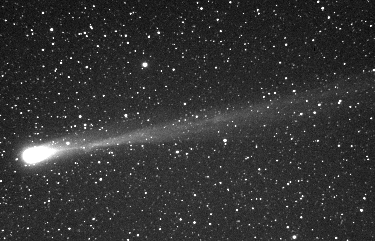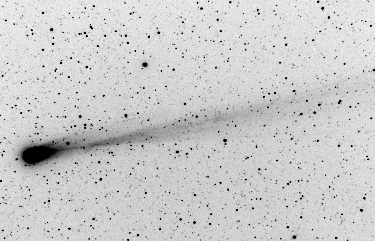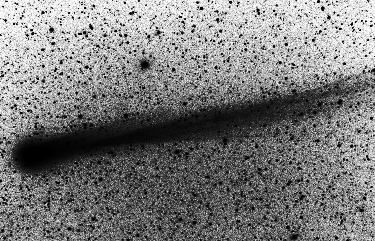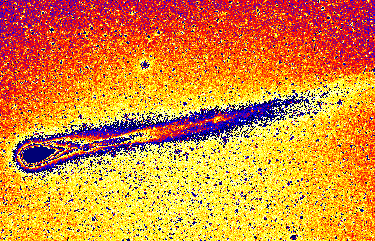

On the evening of March 25–26, 1996 comet C/1996 B2 (Hyakutake) flew by the Earth, approaching to a distance of just a little more than one tenth of an astronomical unit (the average distance between the Earth and the Sun). Even though the comet was not yet at maximum brightness, having not reached perihelion (the point of closest approach to the Sun), its proximity to the Earth made it a magnificent naked-eye object, even in less than perfect skies.
That night, I had the good luck to have cloudless skies with only a little haze on the horizon. By 22:00 local time the comet had risen well above the haze and the tail could easily be glimpsed with the naked eye, even though, due to street lights, the sky was far from dark. I decided to experiment with photographing the comet with a mix of high- and low-technology: a CCD (charge-coupled device) imaging camera coupled to nothing more than a wide-angle lens from a 35mm camera, on a fixed tripod (no drive or guiding). I figured that by combining the extremely high quantum efficiency of the CCD (the electronic equivalent of film speed) with a wide-angle view, I should be able to produce images that showed off details of the comet's tail with exposures short enough to avoid star trails.
I made a number of images to calibrate exposure and determine how long an exposure would be possible without visible star trailing. The first image was a 10 second exposure taken at 21:10 local time (the time zone at my observing site near Neuchâtel, Switzerland (47° north latitude, 7° east longitude) is UTC+1, so this was 20:10 UTC).

In this picture, the blurred image of a tree in the foreground is visible at the bottom left of the frame. The comet is just emerging from the haze and stray light at the horizon. Even with only a 10 second exposure, the CCD image shows much more detail than was visible to the naked eye. Next, I experimented with how long an exposure I could get away with without visible star trailing. The following 30 second exposure, taken around 20:20 local time shows small trails on stars on the right side of the frame (the portion most distant from the celestial pole, which thus has the largest apparent motion).

Based on these results, I decided a 15 or 20 second exposure was the best choice. Then it was just a matter of waiting for the comet to rise into darker skies. At around 22:50 local time, I obtained the image at the beginning of this article, a 20 second exposure. The horizon is parallel to the bottom of the frame in all of these images; you can see the angular extent of the tail in the shift in angle as the comet rises.
Starting with this image, exactly as captured by the CCD camera, we can process it in various ways to reveal subtle details. First of all, let's make a negative of the image:

Many astronomers find it's easier to see detail in extended objects in a negative—here the streamer emerging from the top of the coma is easier to pick out than on the positive image. One of the great things about having images in digital form is that you can view them in lots of different ways without spending hours in a darkroom trying various photographic tricks. To get a better idea of the extent of the tail and fine details within it, let's take the negative image and apply a histogram equalisation algorithm to it. In effect, we'll stretch the brightness range of the picture so that fine gradations in density are spread out over the available intensity range. This gives us the following image:

While this isn't as pretty as the original, it shows a lot of detail we might otherwise miss. First of all, notice that the tail extends to and beyond the edge of the frame—in the original images it appears to fade out. Several streamers in the main tail become much more apparent in the stretched image. Finally, let's try to tease some more detail out of the head of the comet, which is pretty much a nondescript blob on all the images so far.

In this image I've made the brightness wrap around from dark to light and back several times over the intensity range of the image. This causes “isophotes”—areas of the same brightness—to be distinguished. To further highlight the detail, I've shown the image in “false colour”, where the colour changes based on the intensity. Look at the head now—the centre remains overexposed, but you can see bands as the intensity falls off with distance from the nucleus.
All the images were captured using a Santa Barbara Instruments Group (SBIG) ST-6 camera, which uses a 375×242 pixel CCD with pixels of 23 by 27 microns. The CCD detector is 8.6×6.5 millimetres in size. All images were made with the detector cooled to −40° C (to reduce dark current). A Nikon f/2.8 24 mm lens was used for all images (note that the angular extent of the image formed on the CCD chip is much less than the same lens would produce on 35 mm film). The camera was linked by a serial port operating at 56 Kb to a Compaq SLT 386s/20 portable computer, using an NEC MultiSync II monitor (to allow better preview of greyscale images than the monochrome LCD display built into the Compaq).
Captured images were converted from TIFF to GIF with utilities from Jef Poskanzer's pbmplus raster image toolkit. Subsequent image processing was done using John Bradley's xv utility and the Smithsonian Astrophysical Observatory's saoimage package, both running on a Silicon Graphics Indigo² workstation.
The position of the comet in the period while these images were taken is given by the following ephemerides extracted from IAU Circular 6330 of 29th February 1996. If you are interested in this kind of fast-breaking astronomical information, you can obtain your own subscription to the Circulars.
C/1996 B2 (Hyakutake)
1996 TT R. A. (2000) Decl. Delta r Elong. Phase m1
Mar. 25.6 14 24.37 +64 50.8 0.102 1.036 109.3 65.4 0.7
25.8 14 18.71 +68 27.7 0.103 1.032 106.5 68.0 0.7
26.0 14 11.1 +71 59.3 0.104 1.027 103.7 70.7 0.7
26.2 14 00.3 +75 23.4 0.106 1.023 100.9 73.2 0.7
You can view a stereo image of the comet flying past Earth, as it follows its near-parabolic orbit, courtesy of Solar System Live.
This document and all the images it contains are in the public domain and can be used in any way you wish without any restrictions whatsoever.by John Walker